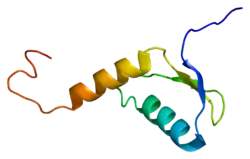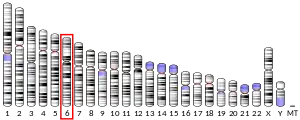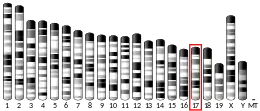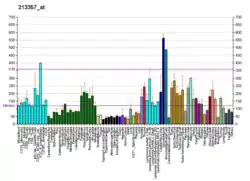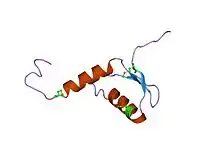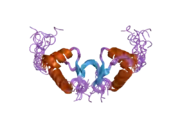GTF2H5
General transcription factor IIH subunit 5 is a protein that in humans is encoded by the GTF2H5 gene.[5][6]
Function
The GTF2H5(TTDA) gene encodes a small (71 amino acid) protein that stabilizes the multi-subunit transcription repair factor IIH(TFIIH). TFIIH plays a key role in a major DNA repair process, nucleotide excision repair (NER), by opening the DNA double helix after the initial recognition of damage in one strand. This step is followed by excision of the damaged region to generate a single-strand gap, and then repair synthesis, using the undamaged strand as template, to accurately fill in the gap. Disruption of the GTF2H5(TTDA) gene in a knockout mouse-model completely inactivates NER.[7] In humans, mutation in any one of four genes can give rise to the trichothiodystrophy phenotype. These genes are TTDN1, XPB, XPD and GTF2H5(TTDA).[7]
References
- GRCh38: Ensembl release 89: ENSG00000272047 - Ensembl, May 2017
- GRCm38: Ensembl release 89: ENSMUSG00000034345 - Ensembl, May 2017
- "Human PubMed Reference:". National Center for Biotechnology Information, U.S. National Library of Medicine.
- "Mouse PubMed Reference:". National Center for Biotechnology Information, U.S. National Library of Medicine.
- Giglia-Mari G, Coin F, Ranish JA, Hoogstraten D, Theil A, Wijgers N, Jaspers NG, Raams A, Argentini M, van der Spek PJ, Botta E, Stefanini M, Egly JM, Aebersold R, Hoeijmakers JH, Vermeulen W (June 2004). "A new, tenth subunit of TFIIH is responsible for the DNA repair syndrome trichothiodystrophy group A". Nat. Genet. 36 (7): 714–9. doi:10.1038/ng1387. PMID 15220921.
- "Entrez Gene: GTF2H5 general transcription factor IIH, polypeptide 5".
- Theil AF, Hoeijmakers JH, Vermeulen W (2014). "TTDA: big impact of a small protein". Exp. Cell Res. 329 (1): 61–8. doi:10.1016/j.yexcr.2014.07.008. PMID 25016283.
- Vermeulen W, Bergmann E, Auriol J, Rademakers S, Frit P, Appeldoorn E, Hoeijmakers JH, Egly JM (November 2000). "Sublimiting concentration of TFIIH transcription/DNA repair factor causes TTD-A trichothiodystrophy disorder". Nat. Genet. 26 (3): 307–13. doi:10.1038/81603. PMID 11062469. S2CID 25233797.
Further reading
- Vermeulen W, Bergmann E, Auriol J, Rademakers S, Frit P, Appeldoorn E, Hoeijmakers JH, Egly JM (2000). "Sublimiting concentration of TFIIH transcription/DNA repair factor causes TTD-A trichothiodystrophy disorder". Nat. Genet. 26 (3): 307–13. doi:10.1038/81603. PMID 11062469. S2CID 25233797.
- Coin F, Proietti De Santis L, Nardo T, Zlobinskaya O, Stefanini M, Egly JM (2006). "p8/TTD-A as a repair-specific TFIIH subunit". Mol. Cell. 21 (2): 215–26. doi:10.1016/j.molcel.2005.10.024. PMID 16427011.
- Giglia-Mari G, Miquel C, Theil AF, Mari PO, Hoogstraten D, Ng JM, Dinant C, Hoeijmakers JH, Vermeulen W (2006). "Dynamic interaction of TTDA with TFIIH is stabilized by nucleotide excision repair in living cells". PLOS Biol. 4 (6): e156. doi:10.1371/journal.pbio.0040156. PMC 1457016. PMID 16669699.
- Vitorino M, Coin F, Zlobinskaya O, Atkinson RA, Moras D, Egly JM, Poterszman A, Kieffer B (2007). "Solution structure and self-association properties of the p8 TFIIH subunit responsible for trichothiodystrophy". J. Mol. Biol. 368 (2): 473–80. doi:10.1016/j.jmb.2007.02.020. PMID 17350038.
